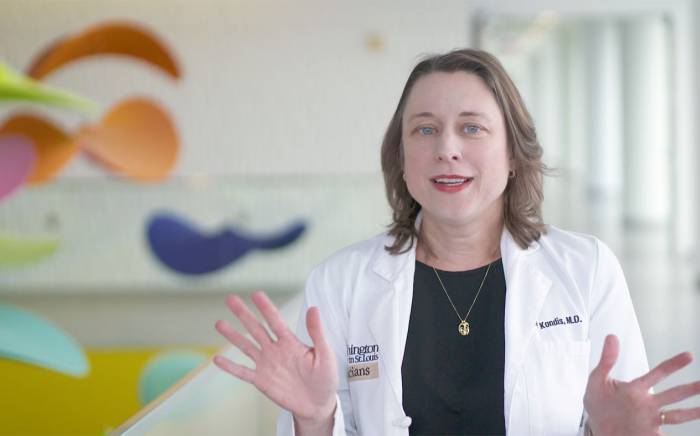Coronal synostosis is one type of craniosynostosis affecting the shape of the front of the head. The term craniosynostosis refers to the premature fusion of the bones of an infant’s head. The skilled surgeons of St. Louis Children’s Hospital treat coronal synostosis and all other types of craniosynostosis in infants.
What is Coronal Synostosis?

In newborns, the bones of the skull are separated by small spaces or growth plates called sutures. One seam runs over the top of the skull from ear-to-ear.
This coronal suture may close (fuse) prematurely on one side (unicoronal) or both sides (bicoronal). When this happens, it is called coronal synostosis.
When only one side is affected, coronal synostosis causes forehead and brow flattening on the affected side. On the opposite side, the forehead tends to be excessively prominent. The eye on the affected side may also have a different shape. When both sides are involved, the forehead tends to be tall and flat.
How is Coronal Synostosis Treated?
Coronal synostosis must be treated with surgery. For children under four to six months of age, we offer a minimally invasive endoscopic technique that only leaves a small scar. For children older than six months, we offer the more traditional, open coronal synostosis repair.
- Endoscopic craniosynostosis repair. This minimally invasive procedure uses a small scope and leaves only small scars. After endoscopic coronal synostosis repair, your child will need to wear a helmet for several months. We will help you make all the arrangements for this. Learn more about post-surgical helmeting. View photo examples of our patients who have had this procedure.
- Open craniosynostosis repair surgery. This classic surgical approach can be performed on children of any age. It involves a larger incision plus the use of plates to hold the bones in place. There is no post-surgical helmeting required after an open craniosynostosis repair. View photo examples of our patients who have had this procedure.
When Does My Baby Need Surgery for Coronal Synostosis?
At St. Louis Children’s Hospital, minimally invasive surgical techniques can be considered when babies are less than six months old, ideally prior to 4 months of age. At the age of two to four months, most infants can be treated with a minimally invasive surgery technique called endoscopic craniosynostosis repair.
This technique reduces pain and scarring. Older children can be treated with an open surgical procedure.
What Causes Coronal Synostosis?
Coronal synostosis can occur with no known cause. Occasionally an underlying medical condition can cause the bones of the skull to fuse prematurely. The following disorders can cause coronal synostosis to occur:
- Pfeiffer syndrome
- Apert syndrome
- Crouzon syndrome
- Jackson-Weiss syndrome
- Muenke syndrome
How is Coronal Synostosis Diagnosed?
Often a physical exam by an expert is the only thing your baby needs to get a diagnosis. Sometimes we take a quick, painless image (X-ray or CT scan) to look at the bones and see if the sutures have fused prematurely.
We know you don’t want to be kept waiting to learn if your baby has a skull abnormality. Whenever possible, we perform all imaging, make a diagnosis and give you a clear treatment plan at your first appointment.
Publications From Our Craniosynostosis Team Related to Coronal Synostosis
- The Temporal Region in Unilateral Coronal Craniosynostosis: Fronto-Orbital Advancement Versus Endoscopic-Assisted Strip Craniectomy
- Postoperative Changes in Orbital Dysmorphology in Patients with Unicoronal Synostosis
- Evaluation of Endoscopic Strip Craniectomy and Orthotic Therapy for Bilateral Coronal Craniosynostosis
Contact Us
If you have concerns about the development of your baby’s head, please call us at 314.454.5437 or toll-free at 800.678.5437. We will gladly evaluate your child.












